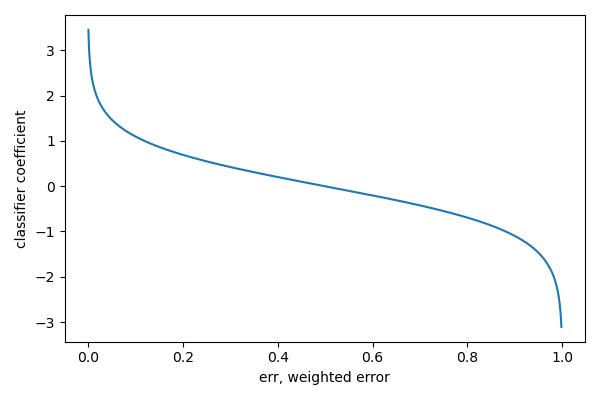Support Vector Machines and Boosting
Support Vector Machines
General Setting
If we use \(t\in\{-1, 1\}\) instead of \(\{0,1\}\), i.e. the model is
Hinge Loss
If we use a linear classifier and write \(z^{(i)}(w,b)=\vec w^T\vec x + b\), then we want to minimize the training loss
This formulation is called support vector machines.
Generally used with \(L_2\) regularization
Optimal Separating Hyperplane
Suppose we want to find a linear classifier that separates a set of data points. In \(\mathbb R^2\), this will looks like a line \(y=wx+b\); in \(\mathbb R^{D>2}\), that will be a hyperplane.
Note that there are multiple separating hyperplanes, i.e. different \(w,b\)'s
A hyperplane that separates two classes and maximizes the distance to the closest point from either class, i.e. maximize the margin of the classifier.
Boosting
Train classifiers sequentially, each time focusing on training data points that were previously misclassified.
Key Idea
learn a classifier using different costs (by applying different weights). Intuitively, "tries harder" on examples with higher cost.
Let misclassification rate be and change cost function
\(w^{(n)}\) is normalized so that the overall weights does not change the overall loss.
Weak Learner / Classifier
Weak learner is a learning algorithm that outputs a hypothesis that performs slightly better than chance i.e. error rate \(>0.5\)
We want such classifiers for they are computationally efficient.
For example, Decision Stump: A decision tree with a single split.
One single weak classifier is not capable of making the training error small. so that
Then, we want to combine many weak classifiers to get a better ensemble of classifiers.
Adaptive Boosting (AdaBoost)
Key steps
- At each iteration, re-weight the training samples by assigning larger weights to samples that were classified incorrectly.
- We train a new weak classifier based on the re-weighted samples
- We add this weak classifier to the ensemble of weak classifiers. This ensemble is the new classifier
- Repeat the process
Boosting vs. Bootstrap
Boosting reduces bias by making each classifier focus on previous mistakes.
Bootstrap reduces variance, while keeping bias the same
Algorithm
data \(D_N = \{x^{(n)}, t^{(n)}\}_{n=1}^N, t^{(n)}\in\{-1,1\}\)
A classifier or hypothesis \(h: \vec x \rightarrow \{-1, 1\}\)
0 - 1 loss: \(\mathbb I(h(x^{(n)}\neq t^{(n)})) = \frac{(1-h(x^{(n)})t^{(n)})}{2}\)
WeakLearn\(:D_N\times \vec w\rightarrow h\) be a function that returns a classifier
AdaBoost(\(D_N\), WeakLearn):
- init \(w^{(n)} = N^{-1}, \forall n\)
- For \(t = 1, ..., T\)
- \(h_t\leftarrow \text{WeakLearn}(D_N, \vec w)\)
- compute weighted error \(err_t = \frac{\sum_1^N w^{(n)\mathbb I(h_t(x^{(n)})\neq t^{(n)})}}{\sum_{n=1}^Nw^{(n)}}\)
- compute classifier coefficient \(\alpha_t = \frac{1}{2}\log(\frac{1-err_t}{err_t}), a_t \in (0, \infty)\)
- update data weights \(w^{(n)}\leftarrow w^{(n)}\exp(-\alpha_tt^{(n)}h_t(\vec x^{(n)}))\)
- return \(H(x) = sign(\sum_{t=1}^T \alpha_t h_t(\vec x))\)
Intuition
Weak classifiers which get lower weighted error get more weight in the final classifier.
Consider the shape of \(\alpha_t\) - If \(err\approx 0, a_t\) high so misclassified examples get more attention - If \(err\approx 0.5, a_t\) low so misclassified examples are not emphasized
Geometric converge
Assume that at each iteration of AdaBoost the WeakLearn returns a hypothesis with error \(err\leq \frac{1}{2} - \gamma\) for all \(t = 1, ..., T\) with \(\gamma > 0\). The training error of the output hypothesis \(H(\vec x) = sign(\sum^T a_th_x(\vec x))\) is at most
under the assumption that weak learner is \(\gamma\)-better than a random predictor.
Additive Model
With a more complex \(H\) by adding more weak classifiers, we expect more complex classifiers overfit. However, this is not often true, sometimes the test error decreases even after the training error is zero.
General Setting
Consider a hypothesis class \(\mathcal H\) with each \(h_i\in\mathcal H:\vec x\rightarrow \{-1,1\}\) being "weak learners", or bases.
Define an additive model with \(m\) terms to be
where \((\alpha_1, ..., \alpha_m) \in \mathbb R^m\) and generally \(a_i\in\mathbb R^+, \sum a_i = 1\). So that \(H_m\) is a linear combination of bases classifiers, like in boosting.
Stage-wise Training
Consider a greedy approach to fitting additive models, known as stagewise training
- init \(H_0(x)= 0\)
-
For \(m=1,..., T\)
- compute the \(m\)-th hypothesis \(H_m = H_{m-1} + a_mh_m\) so that the loss is minimized, i.e.
\[h_m,\alpha_m \rightarrow arg\min_{h\in\mathcal H, \alpha\in\mathbb R}\sum_{i=1}^N \mathcal L(H_{m-1}(x^{(i)}) + \alpha h(x^{(i)}, t^{(i)}))\]- \(H_m = H_{m-1} + \alpha_mh_m\)
Then consider the exponential loss, as a smooth simulation to Hinge loss.
where \(w_i^{(m)}:= \exp(-H_{m-1}(x^{(i)})t^{(i)})\)
Then, notice that \(h(x)\in \{-1, 1\}\) is the classifier so that
Then, our additive model is equivalent to
Thne, define \(I_{t}=\mathbb I(h(x^{(i)}) = t^{(i)}), I_{f}=\mathbb I(h(x^{(i)}) \neq t^{(i)})\), and consider of summation above, we can further group them by
To optimize \(h\), is equivalent to minimize
To optimize \(\alpha\), define weighted classification error:
and with of minimization on \(h\)
Then consider the derivative, where \(W = \sum^N w_i^{(m)}\),
Set to 0
And for each iteration,
Source code
import numpy as np
import matplotlib.pyplot as plt
z = np.arange(-3, 3, 0.01)
plt.figure(figsize=(6, 4))
plt.plot(z, np.maximum(0, 1 - z), label="y=1")
plt.plot(z, np.maximum(0, 1 + z), label="y=-1")
plt.title("Hinge Loss")
plt.xlabel("z")
plt.ylabel("Loss")
plt.legend()
plt.tight_layout()
plt.savefig("../assets/svm_hinge_loss.jpg")
err = np.arange(0.001, 0.999, 0.001)
a = np.log((1 - err) / err) / 2
plt.figure(figsize=(6, 4))
plt.plot(err, a)
plt.xlabel("err, weighted error")
plt.ylabel("classifier coefficient")
plt.tight_layout()
plt.savefig("../assets/svm_error.jpg")
z = np.arange(-2, 3, 0.01)
plt.figure(figsize=(6, 4))
plt.plot(z, np.maximum(0, 1-z), label="Hinge")
plt.plot(z, np.exp(-z), label="exponential")
plt.title("Hinge Loss vs. Exponential Loss")
plt.xlabel("z")
plt.ylabel("Loss")
plt.ylim(0, 3)
plt.tight_layout()
plt.savefig("../assets/svm_vs.jpg")


